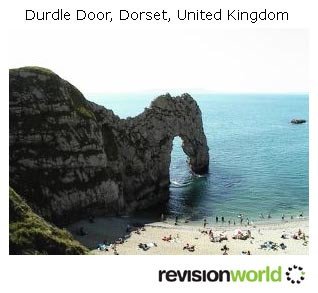This section covers
- Caves, Arches, Stumps and Stacks
- Cliffs and Wave Cut Platforms
- Headlands and Bays
Caves
Waves often tend to find any weakness or crack in a rock and widen it by the process of hydraulic action. This often results in the formation of caves on a headland.
This video explains how caves are formed
Arches
Once the cave has formed, the waves are able to enter and continue eroding back into the headland until they eventually break through to form an arch (for example Durdle Door, Dorset, UK)
In time the base of the arch is attacked by the waves and this puts increasing pressure on the roof of the arch.

Stacks and Stumps
Eventually over time the roof will collapse due to continued erosion and weathering leaving a tall isolated stack (for example Old Harry, Dorset coastline)
The stack is attacked at the base by the force of the waves (undercutting) and will eventually collapse to form a stump.
This video shows how the seas forms arches, stacks and stumps
Cliffs
Sea cliffs are the most common landform of coastal erosion.
Cliffs begin to form when destructive waves attack the base of the rock face between the high and low water marks.
Wave Cut Platforms
Processes such as hydraulic action and corrasion undercut the base of a cliff to form a wave cut notch.
The rock above hangs over the notch (the overhang) and with continued wave attack the notch begins to widen, until the overhangs weight becomes so great it collapses due to the force of gravity.
The waves set about gradually removing all of the waste rock and then begin to attack the new cliff face again.
The process continues again and again until eventually a wave cut platform remains.
The whole process is known as cliff retreat or cliff recession.
Examiners Top Tip: When you are describing cliff retreat remember to include the processes that have caused it: Hydraulic action, corrosion and corrasion.
Headlands and Bays
Headlands and bays forms where a coastline if made up of alternating resistant (harder) and less resistant (softer) rock.
At some points along the coastline the rock will be eroded as it is less resistant and in other areas the rock will remain as it is more resistant.
This results in certain areas of the coastline sticking out to sea to form headlands (for example Flamborough Head, Yorkshire coastline) and other areas are eroded away to form bays (for example Lulworth Cove, Dorset Coastline)
